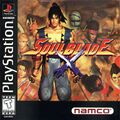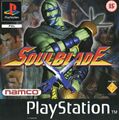Notmyhandle (talk | contribs) (cleanup) |
m (Update guide main page) |
||
| (8 intermediate revisions by 6 users not shown) | |||
| Line 1: | Line 1: | ||
{{Header Nav|game=Soul Edge| | {{Header Nav|game=Soul Edge|custom=[[/Moves/]]}} | ||
{{ | {{Game | ||
|completion=1 | |||
|image=Soul Edge flyer.jpg | |||
|title=Soul Edge | |title=Soul Edge | ||
|developer=[[Namco]] | |developer=[[Namco]] | ||
|publisher=[[Namco]] | |publisher=[[Namco]] | ||
|year=1995 | |||
|systems={{syslist|cade}} | |||
|title1=Soul Edge Ver. II | |||
|developer1=[[Namco]] | |||
|publisher1=[[Namco]] | |||
|year1=1996 | |||
|systems1={{syslist|cade}} | |||
|title2=Soul Edge / Soul Blade | |||
|developer2=[[Namco]] | |||
|publisher2=[[Namco]] | |||
|year2=1996 | |||
|systems2={{syslist|ps}} | |||
|ratings2={{ESRB|T}}{{BBFC|15}} | |||
|designer=Hiroaki Yotoriyama | |designer=Hiroaki Yotoriyama | ||
|genre=[[Fighting]] | |genre=[[Fighting]] | ||
|players=1-2 | |players=1-2 | ||
|modes=[[Single player]], [[Multiplayer]] | |modes=[[Single player]], [[Multiplayer]] | ||
| | |followed by=[[Soulcalibur]] | ||
|series= | |series=Soulcalibur | ||
|seriesDisambig=Soulcalibur | |||
}} | }} | ||
{{ | {{marquee|Soul Edge marquee.jpg}} | ||
{{nihongo|'''Soul Edge'''|ソウルエッジ|''Souru Ejji''|also known as '''Soul Blade'''}} is a [[fighting]] arcade game which was initially released by [[Namco]] in [[1995]]; it runs on Namco System 11 hardware and is the first installment in their [[:Category:Soulcalibur|Soulcalibur series]] (as it became known after its second installment, which had that name, got released three years later, in [[1998]]). "Soul Edge" is the name of the demonic sword around which the series' storyline revolves - and [[Pac-Man]] also makes an appearance for the game's attract sequence. | |||
This game was the second three-dimensional fighting game that featured characters who fought with weapons; however, weapons in a fighting game were not new, for both Namco's own [[Knuckle Heads]] ([[1992]]) and [[SNK]]'s [[:Category:Samurai Shodown|Samurai Shodown series]] (which started in [[1993]]) are examples of two-dimensional fighting games which showcase characters who fight with weapons. Apart from the aesthetic benefits, giving the characters weapons allows for a greater diversity between them, which means that there is a character for every style of play - and some went on to appear in [[Super World Stadium '99]] in [[1999]]. | |||
Soul Edge | On May 16, [[1996]] (less than a full year after the original release), Namco released a "fixed" version of this game named {{nihongo|'''Soul Edge Ver. II'''|ソウルエッジバージョンII|''Souru Ejji Bājon Tsu''}} after a number of players complained that they found the difficulty quite high and the final boss "unbeatable"; additional changes included things such as the introduction of Hwang (initially a palette-swap of Mitsurugi in the game's Korean version) to Japanese players with a new move list, Cervantes becoming playable and Guard Impacts and Air Combos getting implemented along with all of the characters' move lists being changed. The game was then later ported to the [[PlayStation]] on December 20, [[1996]] - and the reason why the international versions for this port were released as "Soul Blade" in [[1997]] was because when Namco tried to register their original name as a trademark outside Japan they ended up getting sued by [[Edge Games]] (who claimed they owned the exclusive right to use the word "edge" in videogames). | ||
<gallery> | |||
File:Soul Edge logo screen.png|Namco logo, ft. Pac-Man. | |||
File:Soul Edge title screen.jpg|The game's title screen. | |||
File:Soul Edge cabinet.jpg|Upright arcade cabinet. | |||
File:Soul Edge character selection screen.jpg|Character select screen. | |||
File:Soul Edge gameplay.jpg|Screenshot of the game. | |||
File:Soul Edge JP PS1 box.jpg|Japanese PlayStation cover. | |||
File:Soul Blade US PS1 box.jpg|US PlayStation cover. | |||
File:Soul Edge pal cover.jpg|European PlayStation cover. | |||
</gallery> | |||
{{ToC}} | {{ToC}} | ||
{ | ==Character Select== | ||
{|align=center | |||
|[[File:Portrait SE Hwang.png|64px|link=Soul Edge/Moves#Hwang|Hwang]] | |||
|[[File:Portrait SE Rock.png|64px|link=Soul Edge/Moves#Rock|Rock]] | |||
|[[File:Portrait SE Taki.png|64px|link=Soul Edge/Moves#Taki|Taki]] | |||
|[[File:Portrait SE Sophitia.png|64px|link=Soul Edge/Moves#Sophitia|Sophitia]] | |||
|[[File:Portrait SE Mitsurugi.png|64px|link=Soul Edge/Moves#Mitsurugi|Mitsurugi]] | |||
|[[File:Portrait SE Soul Edge.png|64px|link=Soul Edge/Moves#Soul Edge|Soul Edge]] | |||
|[[File:Portrait SE Siegfried.png|64px|link=Soul Edge/Moves#Siegfried|Siegfried]] | |||
|[[File:Portrait SE Seung Mina.png|64px|link=Soul Edge/Moves#Seung Mina|Seung Mina]] | |||
|[[File:Portrait SE Li Long.png|64px|link=Soul Edge/Moves#Li Long|Li Long]] | |||
|[[File:Portrait SE Voldo.png|64px|link=Soul Edge/Moves#Voldo|Voldo]] | |||
|[[File:Portrait SE Cervantes.png|64px|link=Soul Edge/Moves#Cervantes|Cervantes]] | |||
|} | |||
{{Soulcalibur}} | |||
[[Category:Namco]] | |||
[[Category:Fighting]] | [[Category:Fighting]] | ||
[[Category:Single player]] | |||
[[Category:Multiplayer]] | [[Category:Multiplayer]] | ||
[[Category: | [[Category:MAME]] | ||
Latest revision as of 16:36, 5 April 2023
This is the first game in the Soulcalibur series. For other games in the series see the Soulcalibur category.

| Soul Edge | |
|---|---|
| Developer(s) | Namco |
| Publisher(s) | Namco |
| Year released | 1995 |
| System(s) | Arcade |
| Followed by | Soulcalibur |
| Series | Soulcalibur |
| Designer(s) | Hiroaki Yotoriyama |
|---|---|
| Genre(s) | Fighting |
| Players | 1-2 |
| Modes | Single player, Multiplayer |
| Soul Edge Ver. II | |
|---|---|
| Developer(s) | Namco |
| Publisher(s) | Namco |
| Year released | 1996 |
| System(s) | Arcade |
| Soul Edge / Soul Blade | |
|---|---|
| Developer(s) | Namco |
| Publisher(s) | Namco |
| Year released | 1996 |
| System(s) | PlayStation |
| Rating(s) | |
Soul Edge (ソウルエッジ Souru Ejji?, also known as Soul Blade) is a fighting arcade game which was initially released by Namco in 1995; it runs on Namco System 11 hardware and is the first installment in their Soulcalibur series (as it became known after its second installment, which had that name, got released three years later, in 1998). "Soul Edge" is the name of the demonic sword around which the series' storyline revolves - and Pac-Man also makes an appearance for the game's attract sequence.
This game was the second three-dimensional fighting game that featured characters who fought with weapons; however, weapons in a fighting game were not new, for both Namco's own Knuckle Heads (1992) and SNK's Samurai Shodown series (which started in 1993) are examples of two-dimensional fighting games which showcase characters who fight with weapons. Apart from the aesthetic benefits, giving the characters weapons allows for a greater diversity between them, which means that there is a character for every style of play - and some went on to appear in Super World Stadium '99 in 1999.
On May 16, 1996 (less than a full year after the original release), Namco released a "fixed" version of this game named Soul Edge Ver. II (ソウルエッジバージョンII Souru Ejji Bājon Tsu?) after a number of players complained that they found the difficulty quite high and the final boss "unbeatable"; additional changes included things such as the introduction of Hwang (initially a palette-swap of Mitsurugi in the game's Korean version) to Japanese players with a new move list, Cervantes becoming playable and Guard Impacts and Air Combos getting implemented along with all of the characters' move lists being changed. The game was then later ported to the PlayStation on December 20, 1996 - and the reason why the international versions for this port were released as "Soul Blade" in 1997 was because when Namco tried to register their original name as a trademark outside Japan they ended up getting sued by Edge Games (who claimed they owned the exclusive right to use the word "edge" in videogames).
-
Namco logo, ft. Pac-Man.
-
The game's title screen.
-
Upright arcade cabinet.
-
Character select screen.
-
Screenshot of the game.
-
Japanese PlayStation cover.
-
US PlayStation cover.
-
European PlayStation cover.
Table of Contents
- Soul Edge (Moves)
- Soulcalibur (Moves)
- Soulcalibur II (Moves)
- Soulcalibur III (Moves)
- Soulcalibur IV (Moves)
- Soulcalibur: Broken Destiny (Moves)
- Soulcalibur V (Moves)
- Soulcalibur VI (Moves)
- 2B
- Abelia
- Abyss
- Algol
- Amy
- Angol Fear
- The Apprentice
- Arthur
- Ashlotte
- Assassin
- Astaroth
- Aurelia
- Azwel
- Berserker
- Cassandra
- Cervantes
- Charade
- Chester
- Dampierre
- Darth Vader
- Demuth
- Devil Jin (style)
- Edge Master
- Elysium
- Ezio Auditore
- Geralt
- Girardot
- Greed
- Grøh
- Haohmaru
- Heihachi
- Hilde
- Hualin
- Hwang
- Inferno
- Ivy
- Kamikirimusi
- Kilik
- Kratos
- Leixia
- Li Long
- Link
- Lizardman
- Luna
- Lynette
- Maxi
- Miser
- Mitsurugi
- Natsu
- Necrid
- Nightmare
- Olcadan
- Patroklos
- α Patroklos
- Pyrrha
- Pyrrha Ω
- Raphael
- Revenant
- Rock
- Scheherazade
- Seong Han-Myeong
- Seong Mi-na
- Setsuka
- Shura
- Siegfried
- Sophitia
- Spawn
- Strife
- Taki
- Talim
- Tira
- Valeria
- Viola
- Voldo
- Xianghua
- Xiba
- Yoda
- Yoshimitsu
- Yun-Seong
- Zasalamel
- Z.W.E.I.
Character Select[edit]

|

|

|

|

|

|

|

|

|

|

|







